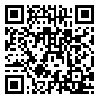Volume 4, Issue 2 (July-Sep 2015)
JCHR 2015, 4(2): 114-127 |
Back to browse issues page
1- Environmental Health Engineering Research Center, Kerman University of Medical Sciences, Kerman, Iran , nasiri_a62@yahoo.com
Abstract: (7897 Views)
Introduction: Using bio-sorbents is regarded as one of the effective methods to remove heavy metals. Therefore, this study aimed to investigate Pb adsorption from contaminated water by Chaetoceros sp. and Chlorella sp. algae.
Methods: This experimental study was conducted in a batch reactor. The amount of Pb adsorption by Chaetoceros sp. and Chlorella sp. algae was studied under such conditions as different adsorbent dosages (0.2, 0.5, 1.5 and 2 g/L), different pH (3, 4, 5, 6, 7, 8), different temperatures (20, 25, 30, 35, 40 °C), different contact times (30, 60, 90, 180, 360 minutes), different particle sizes (20, 40, 60, 100, 140 mesh) and different Pb concentrations(20, 40, 60 mg/L). Then adsorption isotherms and kinetic models of metal ions were determined based on Langmuir and Freundlich isotherms as well as first and second order kinetic models.
Results: The efficiency of Pb removal by Chlorella sp. and Chaetoceros sp. algae was reported 78% and 60% respectively. The maximum adsorption was observed at optimal conditions including 25 °C, pH of 6, 180 minutes of contact time, particle size of 20 mesh, 1.5 gr/L of adsorbent and 20 mg/L concentration of Pb. Chlorella algae was observed to remove Pb more than Chaetoceros algae. Based on the study results, Pb absorption by Chlorella algae complies with Langmuir adsorption isotherm model, whereas Chaetoceros algae follows Freundlich model. The kinetic models of algae adsorption followed a second order equation.
Conclusion: The study findings revealed that Chlorella algae can be effectively used in order to adsorb Pd from contaminated water due to its high efficiency of Pd adsorption.
Review: Research |
Subject:
Environmental Health
Received: 2015/07/17 | Accepted: 2015/08/30 | Published: 2015/09/13
Received: 2015/07/17 | Accepted: 2015/08/30 | Published: 2015/09/13
| Rights and permissions | |
 |
This work is licensed under a Creative Commons Attribution 4.0 International License. |


